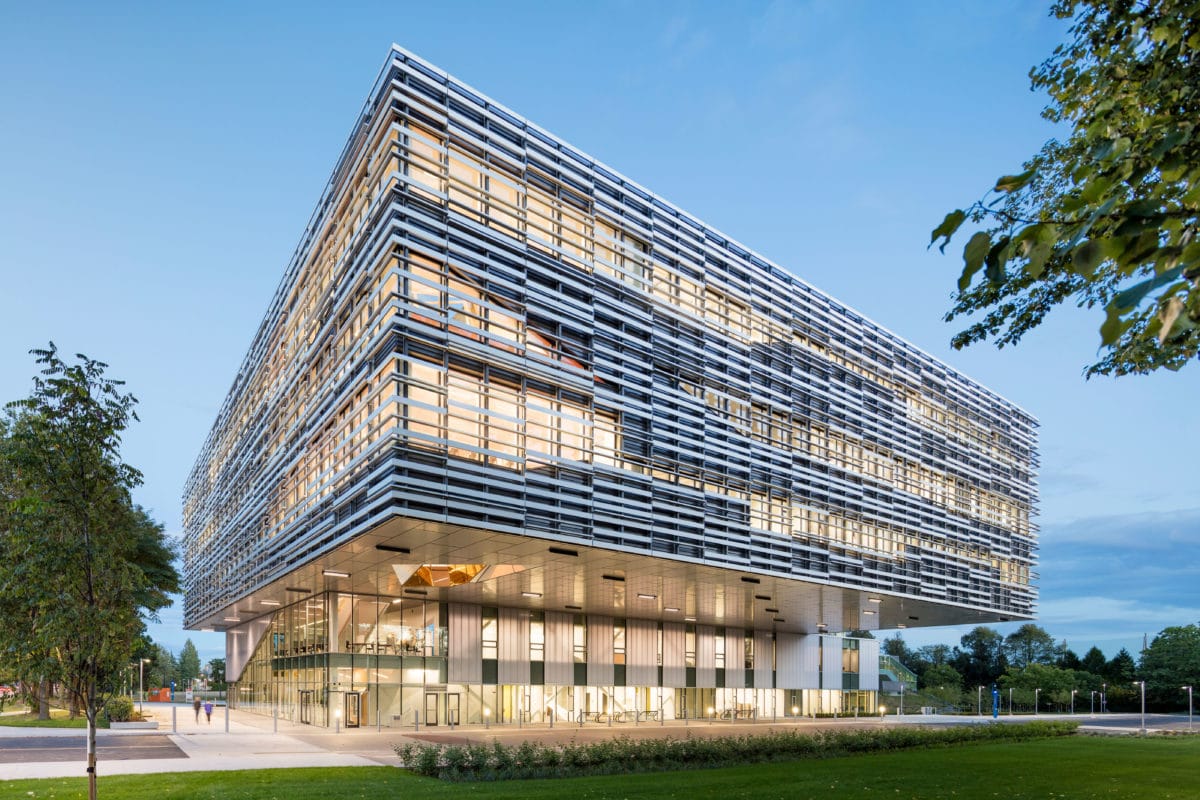
Natural light fills Vancouver’s Langara Science & Technology building, from a massive light well to large windows in classrooms. [Photo by Andrew Latreille]
From human-centric lighting to conservatory spaces, yoga rooms, and breathable walls, the latest green design strategies focus on physical and mental well-being.
At least since the awareness of Sick Building Syndrome (SBS) in the late 1970s, there has been a growing interest in how design can affect people’s physical, social, and psychological health. The term became common after a 1984 World Health Organization report noted that up to 30% of new and existing buildings were subject to complaints related to indoor air quality. This was cause for concern since, according to the EPA, more than 90% of our time is spent indoors, and with an average of 40 hours spent per week at work, a typical employee will spend 10 years of their lifetime in the office. Yet poor ventilation and toxic chemical and biological by-products create an indoor environment that can be up to five times more toxic than outdoor air.
With design professionals turning their attention to the impact their profession can have on human health, the green design movement has shifted towards a more holistic approach to the built environment. Architects, engineers, manufacturers, and builders are all now pushing for strategies that emphasize occupant health as much as reduction in energy consumption and resource conservation. Some practicing architects, like COOKFOX Architects’ Rick Cook, claim the shift indicates a further stage in the evolution of green design. “By the end of the first wave of the green building movement, everyone was familiar with the impact of buildings on the energy footprint,” says the founding partner of the New York-based firm, “Then it evolved into the impact buildings and occupants have on natural systems. But we’re now talking about quantifiably better air and access to daylight. We set out to make buildings better for the planet, and what we stumbled on is making buildings better for people.”
So how can designers create healthier spaces? Here are some leading strategies green designers use to create healthy buildings.
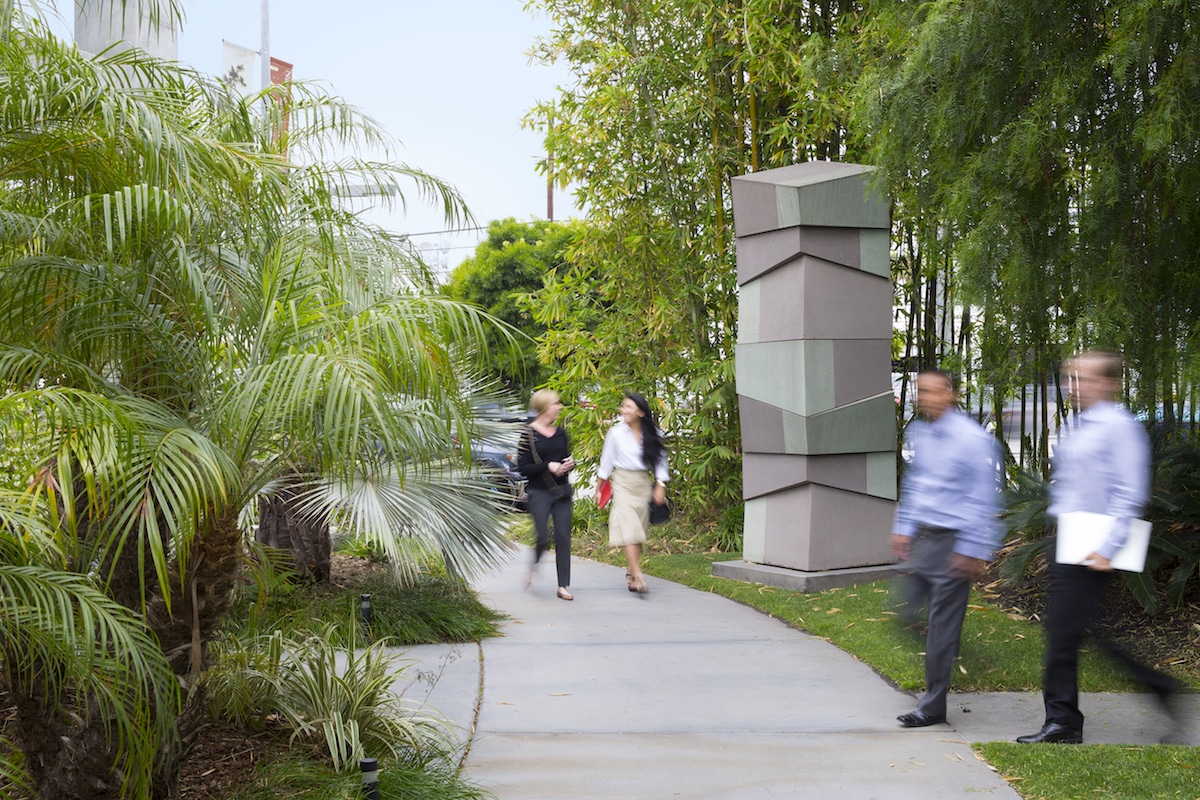
Simple design solutions can have big impact on our physical and mental health. [Photo: Courtesy of Kilroy Realty Corporation]
Select Green Products
The growing demand and availability of green products has prompted practitioners in the construction industry to move beyond just aesthetics and cost and be cognizant of materials’ impact on human health and environment. The federal government has defined Environmentally Preferred Products (EPPs) as those with “a lesser or reduced effect on human health and the environment when compared to competing products that serve the same purpose.”
Designers are using innovative approaches to create new materials that address health and environmental concerns. Biodegradable materials have increased in popularity and offer a sustainable alternative to their plastic-based counterparts. Ecovative, a biotech company in New York City, uses biofabrication processes to literally “grow” materials from agricultural byproducts. Mycelium, a vegan ingredient with a threadlike structure, binds together the organic byproducts and hardens into a high-performance surface that is used in buildings as insulation, SIPs, and acoustic tiles. Others, like AMAM, an award-winning group of Japanese designers, use inspiration from common ingredients in the food industry. They proposed agar, a seaweed byproduct common in the Japanese household, as a sustainable alternative to synthetic plastics.
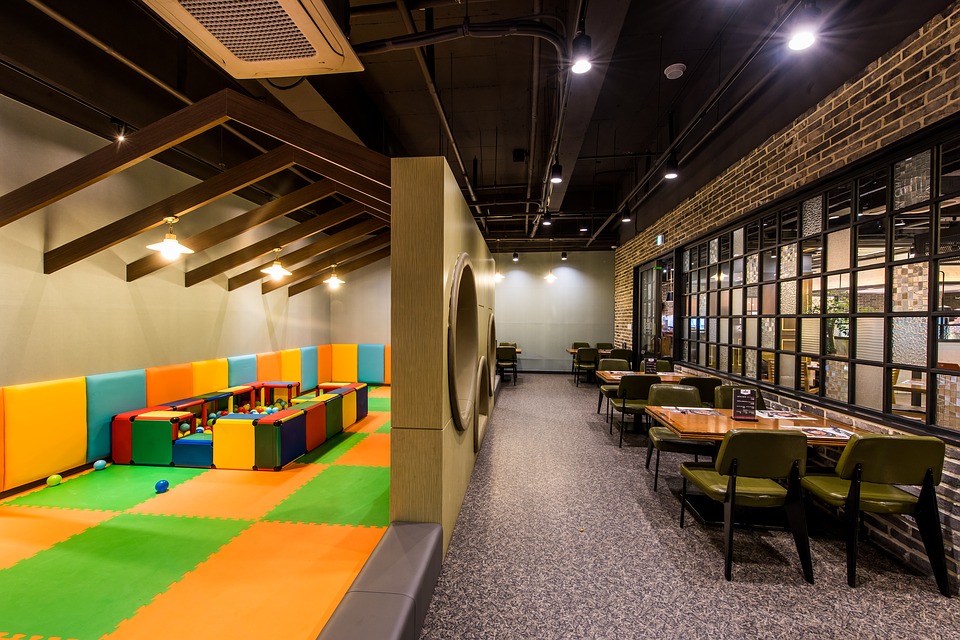
A daycare center requires durable, low-maintenance materials and an air-filtration system to reduce airborne containments and odors that could impact children’s health. [Photo: Pixabay]
Improve Air Quality
In one of the most cited green design studies, Harvard University professors Joseph Allen and John Spengler investigated the impact of indoor air quality on cognitive function. In the 2015 report, they studied workers in both conventional and green buildings to determine the cognitive impact of volatile organic compounds (VOCs) and carbon dioxide levels in the air.
Based on the results, employees who worked in a low-VOC environment performed 101% better in cognitive tests than those in conventional settings. This could generate and increase in productivity of $6,500 per person per year. Yet the cost of increasing ventilation averages only $14 to $40 per person. They further found a 5.4% increase in cognitive scores when occupants were kept in optimal temperature and humidity levels. In green buildings, there were also 30% fewer workplace-related complaints, which indicates the significance of green design strategies for healthier living environments.
The impact of ventilation and indoor contaminants is an ongoing area of research. According to Anthony Burnheim, principal of green design at SMWM, several aspects affect indoor air quality, including ventilation efficiency, construction materials, furnishings, equipment, and the outside air quality. To minimize the negative impact of indoor air contaminants, it is important to design in ways that reduce mold growth, avoid moisture accumulation, and reduce the source of pollutants. International Living Future Institute ( ILFI) offers a red list that is a helpful resource for weeding out products with toxic, harmful chemicals. Providing adequate ventilation and keeping buildings clean were also important design and maintenance factors.
Another way of improving IAQ is through collaborative design. Collaborating with all team members—from interior designers to HVAC engineers—from the beginning of the design process, allows them to define IAQ goals early on and consider those objectives when selecting materials or ventilation systems. Known as the world’s most sustainable office building, Bloomberg’s new European headquarters enhances IAQ by using carbon-dioxide detectors and changing airflow based on occupancy levels. Also, the exterior has “breathable” finned walls that open and close based on the weather. “The breathable walls are like opening a window at home,” says Michael Jones, the project architect and a senior partner at Foster+Partners. “You feel better. It’s the same kind of effect on a much larger scale.”
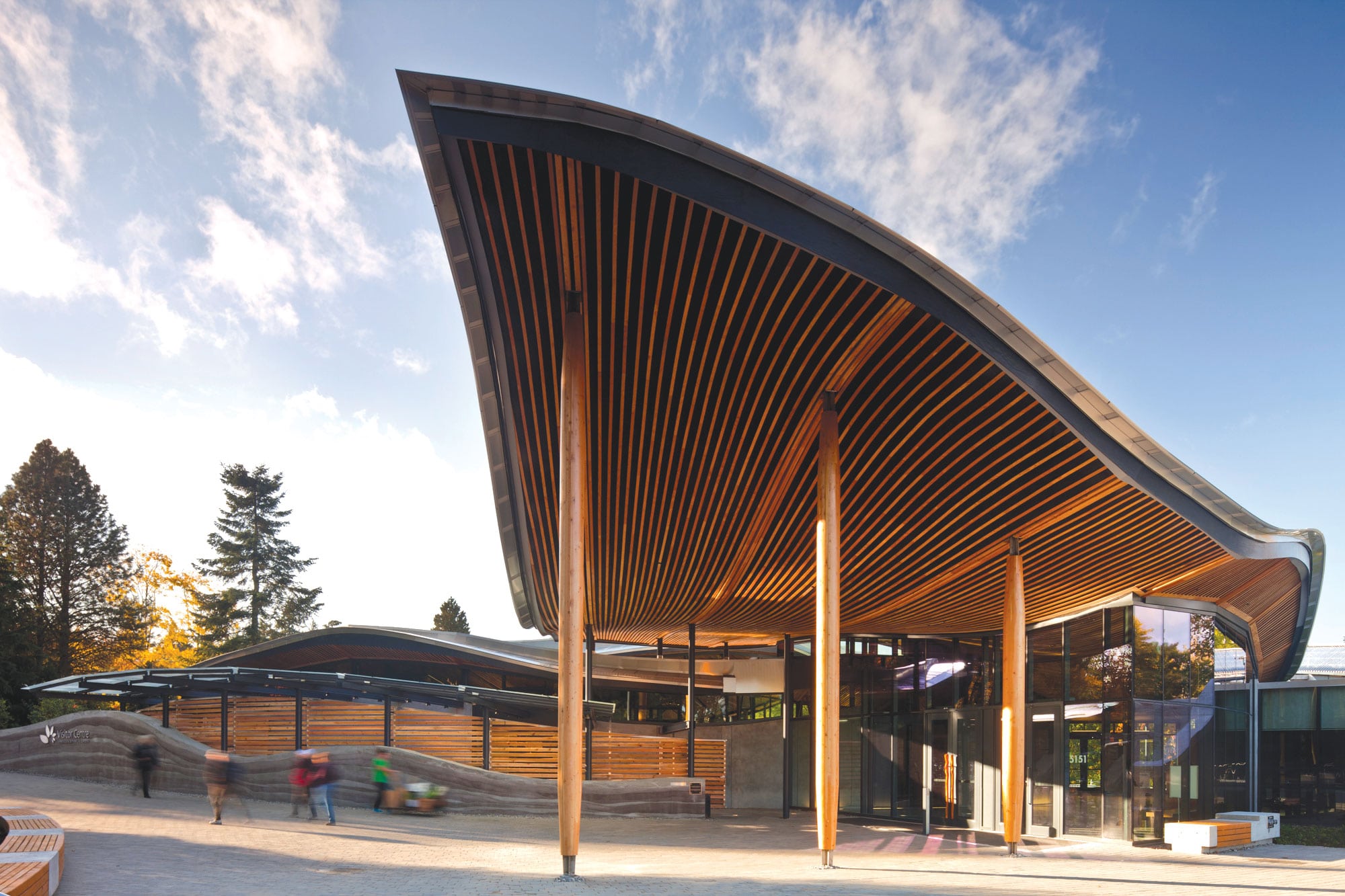
Buildings bring life to our connection to nature by using nature-inspired forms like in VanDusen Botanical Gardens Visitor Center [Photo: Courtesy of VanDusen]
Integrate Nature
In 1986, the renowned evolutionary biologist Edward Wilson popularized the term “biophilia“ to illustrate that humans have an innate desire to connect with nature. Since then, a growing body of research has proven Wilson right. A 2008 University of Michigan study found, for instance, that a walk through nature can increase cognitive function by 20%. In a 2012 study, a group of Chinese university students linked forest environments to reduced inflammation, oxidative stress, and levels of the stress hormone cortisol. Based on a 2007 medical study in Tokyo, natural environments can also increase levels of anti-cancer proteins in the blood.
Biophilic design is a burgeoning field with an idea as old as time. Humans have built shelters based on their climate and natural environment for thousands of years. Nowadays, the practice goes far beyond a few plants in the office; designers are using innovative strategies to foster connection with nature, thereby encouraging occupant well-being. As Amanda Sturgeon, CEO of ILFI, notes, “Biophilic design is ultimately about making happier, healthier spaces where both people and nature can thrive.”
Another example is the Clara Valley Medical Center‘s new Sobrato Pavilion, a treatment clinic for traumatic brain injury sufferers, which connects to existing buildings on-campus via a beautiful green atrium lobby link. It not only functions as “a conservatory space”, according to Alan Codd, a member of its design team, but it’s also “a place where patients, if they’re able to on their own, and general visitors can gather and contemplate. It’s elements like that that go above and beyond garden variety clinical care.”

An emphasis on natural lighting helps make the Sobrato Pavilion one of the least energy- and water-consumptive facilities of its kind. It also reflects a conscious decision to provide a sense of welcome through design. [Photo: David Wakely]
Increase Mobility
A leading strategy in healthier buildings is to create spaces that promote a more active lifestyle. This is significant because, based on a study by the Centers for Disease Control (CDC), only one in five adults in the United States gets the recommended daily amount of physical activity and more than 39% of adults are obese, which is up from 30.5% in 2000. The Center for Active Design (CAD) is a non-profit organization based out of New York City that aims to address obesity and related health issues by developing practicing guidelines for designers based on the latest research. According to its CEO, Joanna Frank, sometimes the greatest potential for healthier workplaces exist in everyday projects. Simple solutions such as locating the building in a walkable neighborhood and with easy access to public transit, or carefully designing sidewalks and entryways, can create a healthier environment by encouraging increased mobility.
Another way design can promote physical activity is to create bright and inviting stairwells. “If you enter a building and immediately see a well-designed stairwell, you’re many times more likely to go up those stairs.” says Frank. “And just six flights of stairs a day is enough to offset the annual average weight gain of an American. So this is the kind of small change that has a big impact on a person’s overall health.” In other projects, like the Etsy workplace in Brooklyn, design elements that improve employee health include providing ample storage space for bikes, incorporating meditation and yoga rooms, day-lit stairs, and collaboration spaces. The result? A happier, healthier workforce.

Smart lighting solutions transform Seattle’s Atlas Workbase. [Photo: Courtesy of Gensler]
Improve Lighting Quality
The quality of lighting is crucial for creating healthier living environments. It affects our sleep, mood, focus, and productivity. Dark spaces, heavy glare, and poorly designed controls are among the most common complaints in workplaces. The constant use of artificial lighting has led manufacturers to come up with innovative technologies that improve their quality. Energy Focus, a leading provider of LED products, donated high-quality LEDs like Intellitube to classrooms across the New York tristate area and the results were encouraging. Not only did it improve aesthetics, it also had a visible impact on students’ participation levels and their learning abilities. “What we hear from teachers is, ‘I can’t explain it, but my kids are more attentive, especially in the afternoons,’” says Tim Evans, vice president of E3 and one of the contractors using Energy Focus LEDs, “A lot of that goes back to circadian rhythms and how your body naturally responds to daylight. Because the LEDs resemble sunlight, students are more alert and pay more attention.”
According to daylighting experts, people need to reset their circadian rhythms every day, and daylighting and human-centric circadian lighting are essential for that purpose. In some cases, like the Langara Science and Technology Building in Canada, natural lighting is the chief lighting design strategy. More than 90% of spaces have views to the outside, and with the addition of skylights and light wells, the building uses little ambient lighting and hence reduces its energy consumption as well.
Sometimes, integrative strategies offer better lighting solutions. In Atlas Workbase, a co-working space in Seattle, natural light is used parallel to advanced systems, such as roller shade systems, to transform spaces and improve productivity. With only one wall that provides natural light, creating a well-lit space was a significant challenge. This led lumenomics to use roller shade systems and adjustable controls based on the time of day, while deeper spaces like conference rooms feature a luminous ceiling that resembles sunlight. The result was a noticeable improvement on employee productivity. “People tell us every day, ‘I’ve never had a more productive day of work,’” says Bill Sechter, Atlas Workbase CEO and cofounder. “Because we invested in the health and wellness and client experience of our members, lighting has really added to Atlas Workbase and our experience here.”
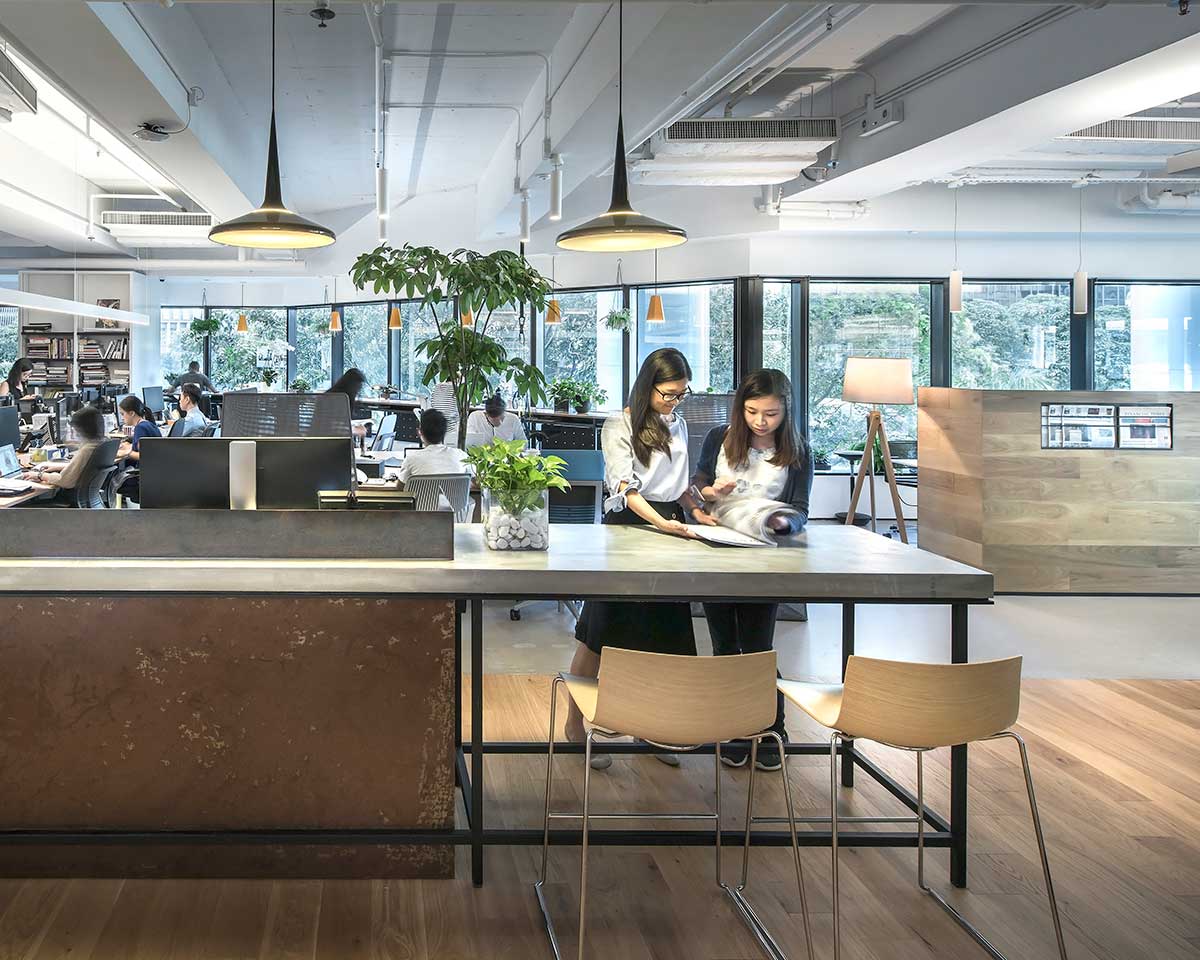
Tree-table designs enable occupants to gather in sun-lit areas, experiencing the shade of the tree in a more casual and productive environment. [Photo: Courtesy of M Moser Associates]
Design for Comfort
Beyond improving quantitative measures like air quality, lighting, and mobility, green design can also affect our mental well-being by helping us to feel better within a space. Based on a recent study by Kelton on behalf of the National Business furniture (NBF), 92% of employees believe that the interior design of their workspace has a significant impact on their mental well-being and productivity. According to Christine Bruckner, a 2018 WSLA recipient and the leader of M Moser Associates‘ global WELL integrative design solution initiatives, small design changes can significantly improve our sense of well-being in a space. In office design, using green walls on wheels, movable partitions, or multi-purpose zones maximizes flexibility by transforming a given space based on the varying needs of its users.
Flexibility is a key factor for user comfort, but it needs to be balanced against privacy. The result of NBF’s study show that 43% of respondents believe not having privacy would affect their mental well-being, and 25% valued flexible working areas away from their everyday space. In redesigning the office space for Sizmek, a digital advertising company, NBF built out a colorful, vibrant space with a blend of collaborative and private spaces: open desks and breakout meeting areas as well as small conference rooms and phone booths to take personal calls.
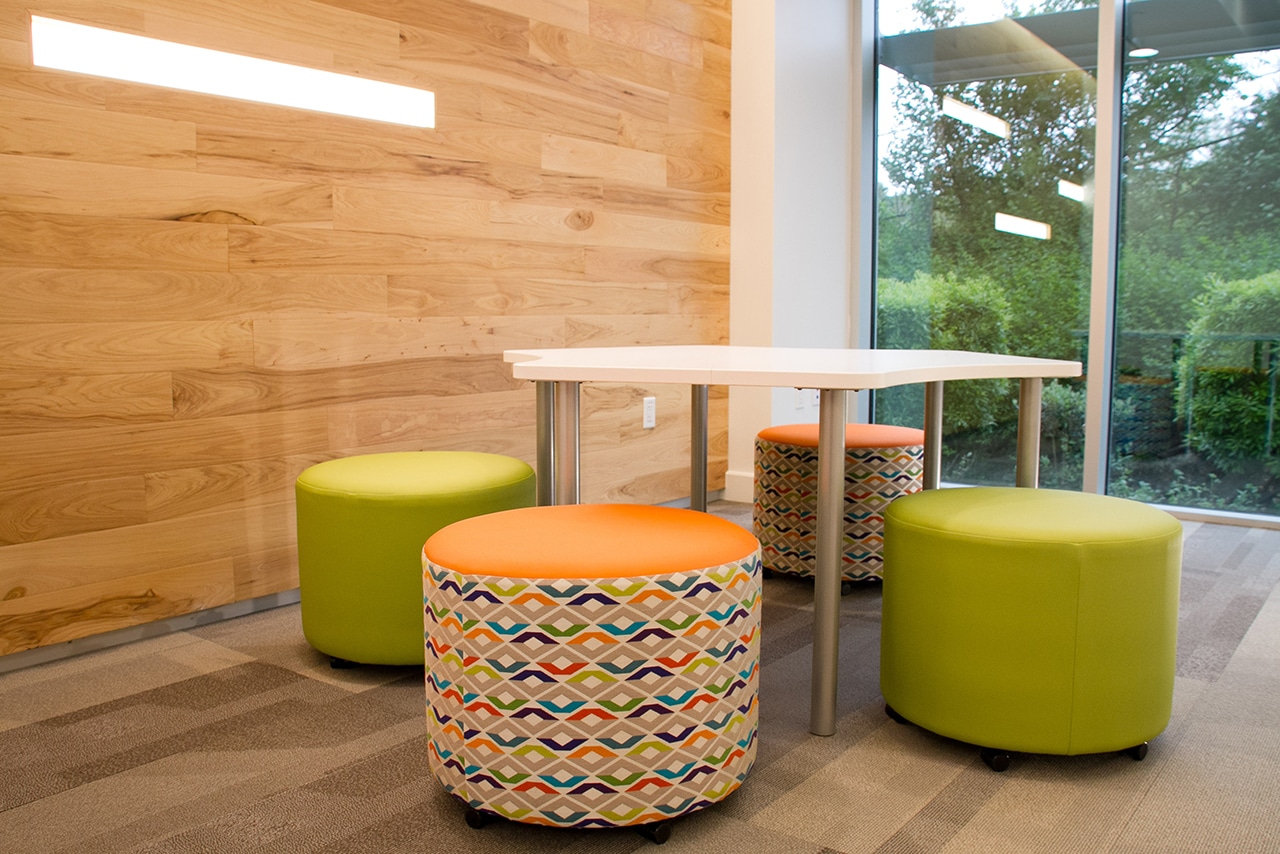
National Business Furniture transformed Sizmek with colorful, comfortable spaces. [Courtesy of NBF]
According to Rusty Jenkins, NBF’s Regional Sales Manager, fancy solutions are not always the way to go. Sometimes, small changes like updating the break room or redesigning conference rooms can help immensely with employee satisfaction and well-being. “When it comes to employee retention and recruitment, a lot of attention has been given to things like adding ping-pong tables and creating Silicon Valley-type environments, but that’s really not what’s driving great office spaces,” he says. “It’s about making people comfortable, with different spaces for different needs—having open space but being careful not to ostracize your introverts. Acknowledging that the nature of work is changing and doing small things to your office can make a really big difference.”
